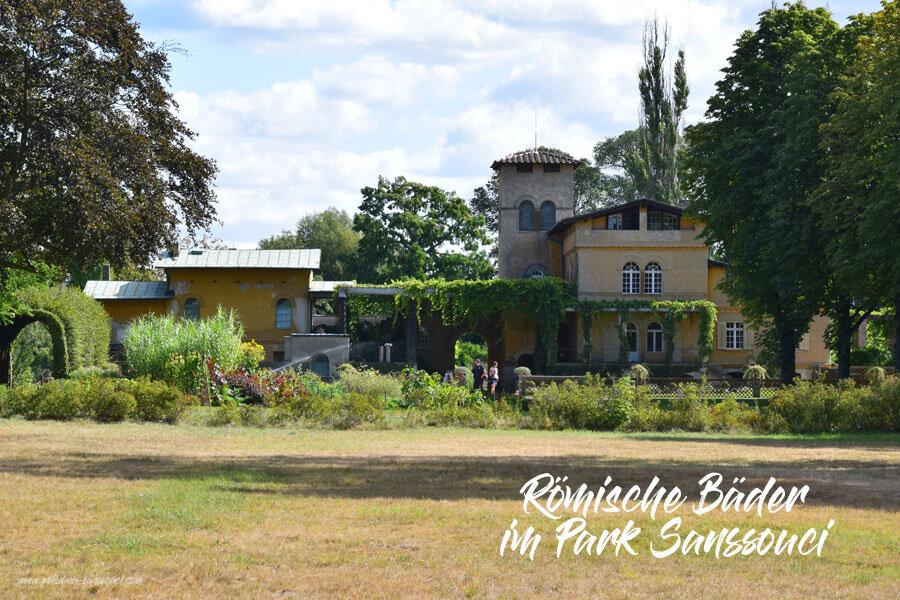
Roman Baths in Sanssouci Park
The Roman Baths, located northeast of Charlottenhof Palace in the Sanssouci Park in Potsdam, are a remarkable example of the Prussian King Frederick William IV’s longing for Italy. Built between 1829 and 1840, this ensemble unites various Roman-Italian architectural styles, offering a nostalgic glimpse into ancient and classical Italy. Today, the Roman Baths are often used for special exhibitions and provide fascinating insights into the romantic architecture of the 19th century.
Table of contents
Roman Baths in Sanssouci Park: A Masterpiece of Romantic Architecture with Italian Influences
While still Crown Prince, Frederick William IV initiated the construction of Charlottenhof Palace (1826–1829) and subsequently the Roman Baths. With his artistic talent and numerous design sketches, he significantly influenced the plans of architect Karl Friedrich Schinkel. Schinkel’s student, Ludwig Persius, oversaw construction. Alongside Schinkel and Persius, who implemented the Crown Prince’s ideas, Peter Joseph Lenné played a crucial role in the landscape design. Between 1829 and 1840, the ensemble was built, including the gardener’s house, a pavilion styled as a Roman podium temple with a columned portico, the assistants’ house, a large pergola, an arcade hall, and finally the Roman Bath.
Roman Baths: Architecture and Construction
The Roman Baths ensemble comprises several buildings, all styled in the Italian manner. The gardener’s house (1829/1830) and the gardener’s assistant house (1832) were built in the style of Italian country houses. The actual Roman Bath (1834–1840), which gave the ensemble its name, reflects the style of ancient villas, while the Tea Pavilion (1830) resembles an ancient temple. These buildings are connected by pergolas, arcades, and garden elements, echoing impressions Schinkel gathered on his second journey to Italy in 1828.
Notable are the room names, blending terms from ancient Roman villas and baths. The reception room is designed as an atrium, a common feature in Roman houses. Behind the atrium lies the impluvium, a rainwater collection basin in ancient times, here conceptualized as a dedicated room. The viridarium is a small garden courtyard, while the apodyterium (changing room) and caldarium (hot bath) are the only names directly referencing Roman baths.
The romantic character of the Roman Baths is enhanced by their location on an artificial lake, the so-called Machine Pond. This pond was created by Peter Joseph Lenné during the landscaping of the Charlottenhof area. Its name derives from a steam engine house with a pumping station, demolished in 1923. A large fountain bowl now marks the former location of this building. The steam engine not only supplied water to the area but also symbolized technological progress of the era.
The Roman Baths form a picturesque contrast to the more austere Charlottenhof Palace, evoking an idealized Italian country estate. Elements like Dionysian herms, Pompeian column fragments, an ancient centaur sarcophagus, and flowerbeds with Mediterranean plants reinforce associations with Italy.
While not a replica of ancient Roman baths, the Baths are an architectural reimagining inspired by a 15th-century Italian country house. Newly discovered archaeological insights from excavations in Herculaneum and Pompeii also influenced their design. Rooms such as the atrium, impluvium, caldarium, apodyterium, viridarium, and billiard room were executed in a colorful and whimsical manner, lending the ensemble a playful and romantic charm.
The buildings feature shallow saddle roofs, a tower, asymmetrically arranged structures, vine-covered pergolas, and a terrace with views of the lake and Charlottenhof Palace. These elements make the Roman Baths an unmistakable retreat of Frederick William IV, visited by notable figures like Alexander von Humboldt during their stays in Potsdam.
The renowned architects Karl Friedrich Schinkel and Ludwig Persius created a masterpiece with the Roman Baths, reflecting the Prussian king’s longing for Italy and the artistic currents of their time. This ensemble remains a testament to the cultural connections between Prussia and Italy and a highlight within Sanssouci Park in Potsdam.
Address
Roman Baths
Sanssouci Park
14471 Potsdam
Images
Frequently Asked Questions
What is the cost of visiting Sanssouci Park and Sanssouci Palace?
Sanssouci Park is free of charge, though a voluntary contribution to park maintenance is appreciated. You can enjoy guided tours and activities by choosing one of our partners' top offers. The best option for visiting Sanssouci Palace is the "Sanssouci+ Ticket" (including Sanssouci Palace), which grants one-time access to all* open palaces of the Prussian Palaces and Gardens Foundation Berlin-Brandenburg in Potsdam.
How many days should you plan for a visit to Potsdam?
Take your time to explore Potsdam. Plan a multi-day trip to experience the city at a relaxed pace. We have carefully selected the best hotels in Potsdam for your stay. Enjoy your visit!
Which sights should you not miss when visiting Potsdam?
Where can I park near Sanssouci Park?
For a safe arrival by car in Potsdam, we have compiled key information on the best parking lots and parking options around Sanssouci Palace and Sanssouci Park. Enjoy your time in Potsdam worry-free!
